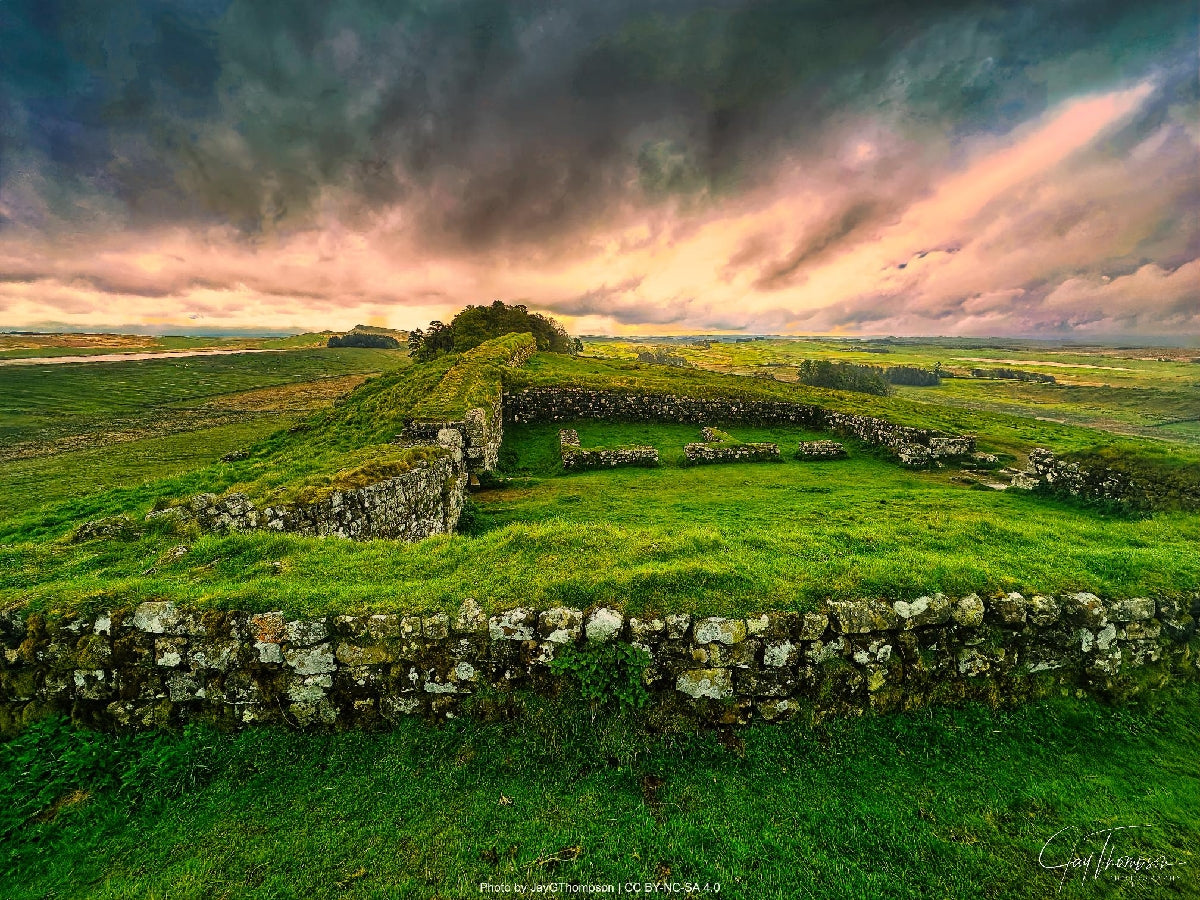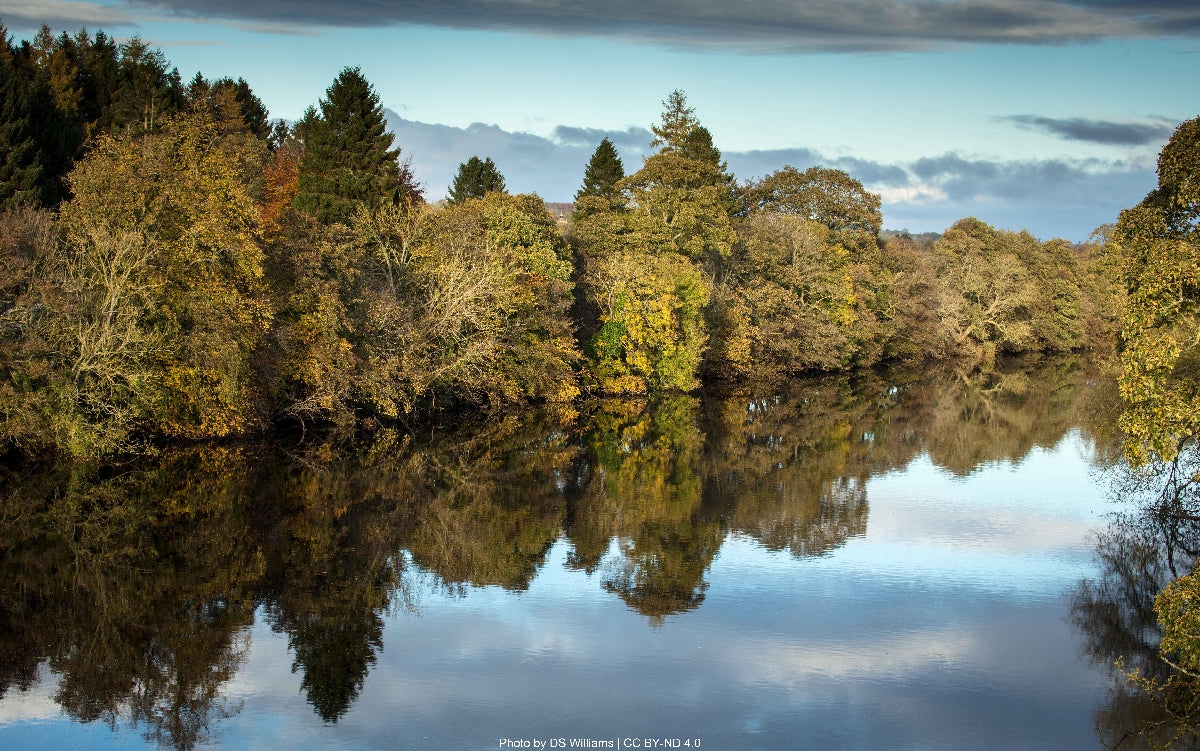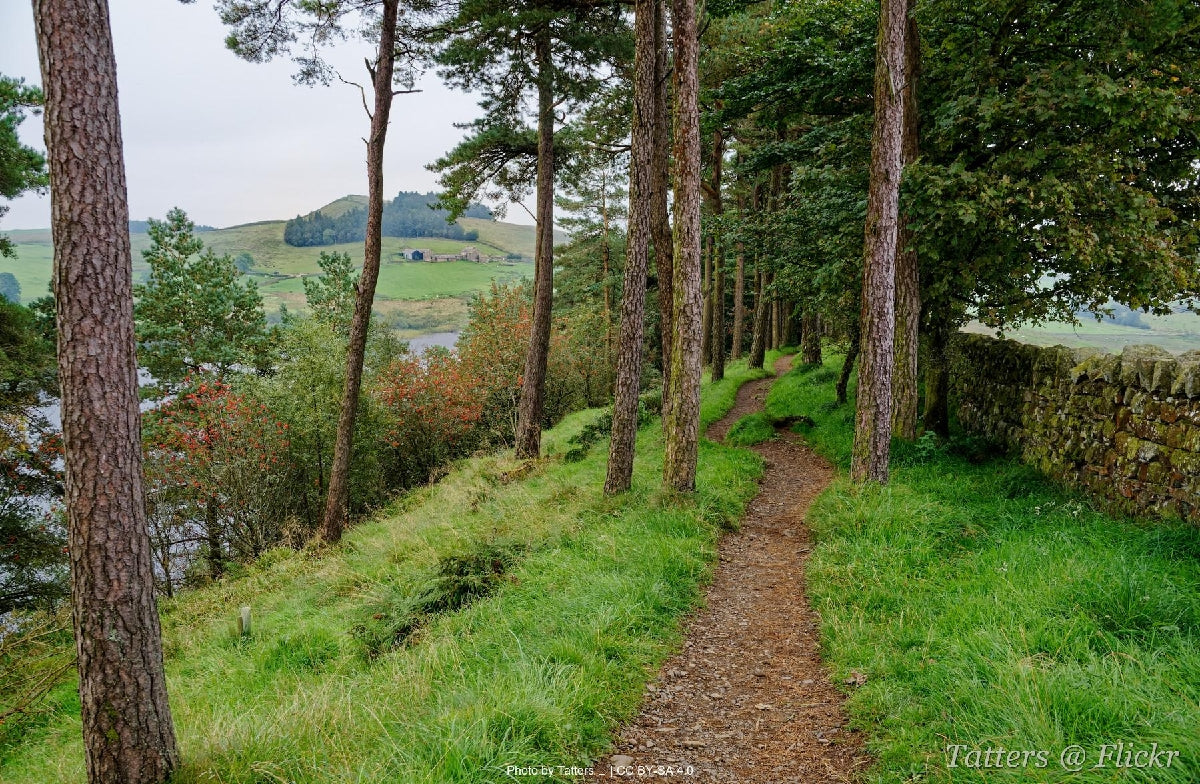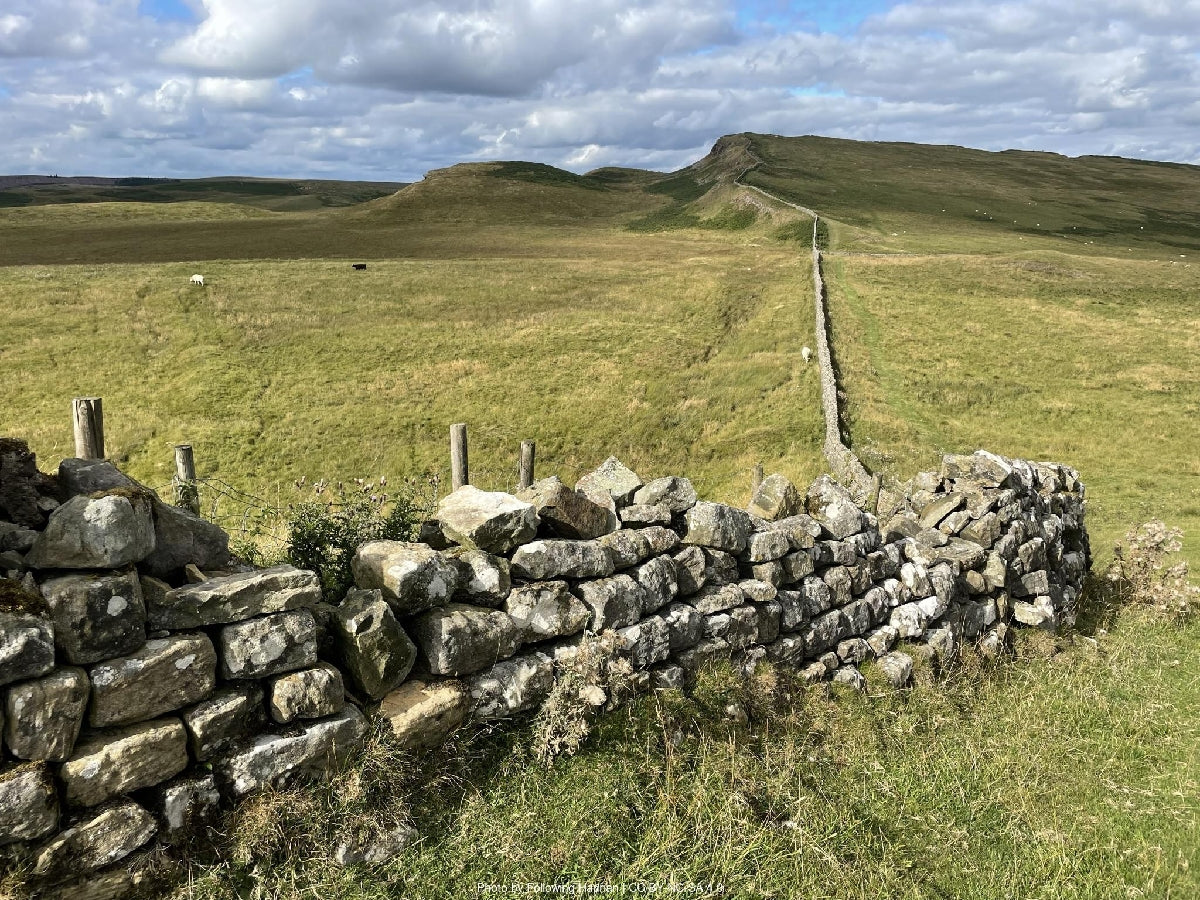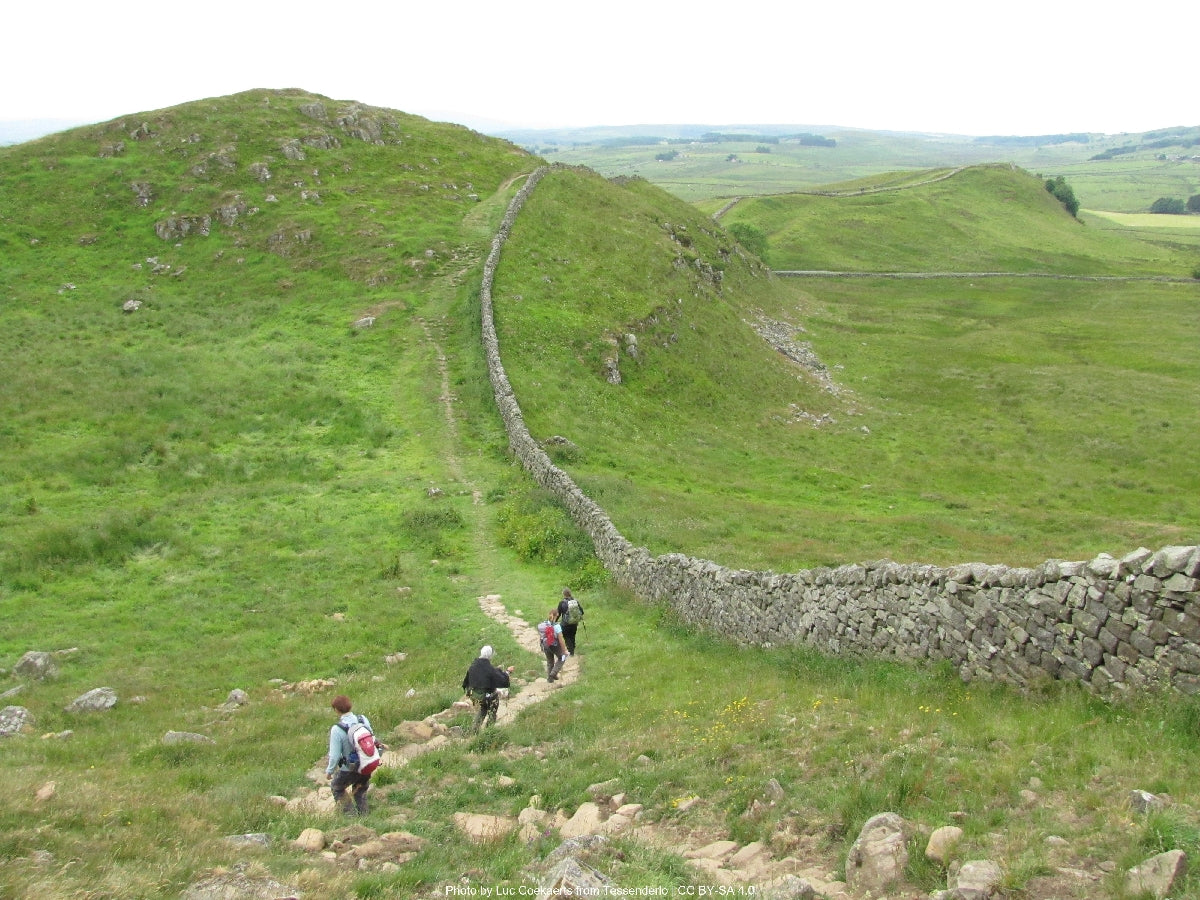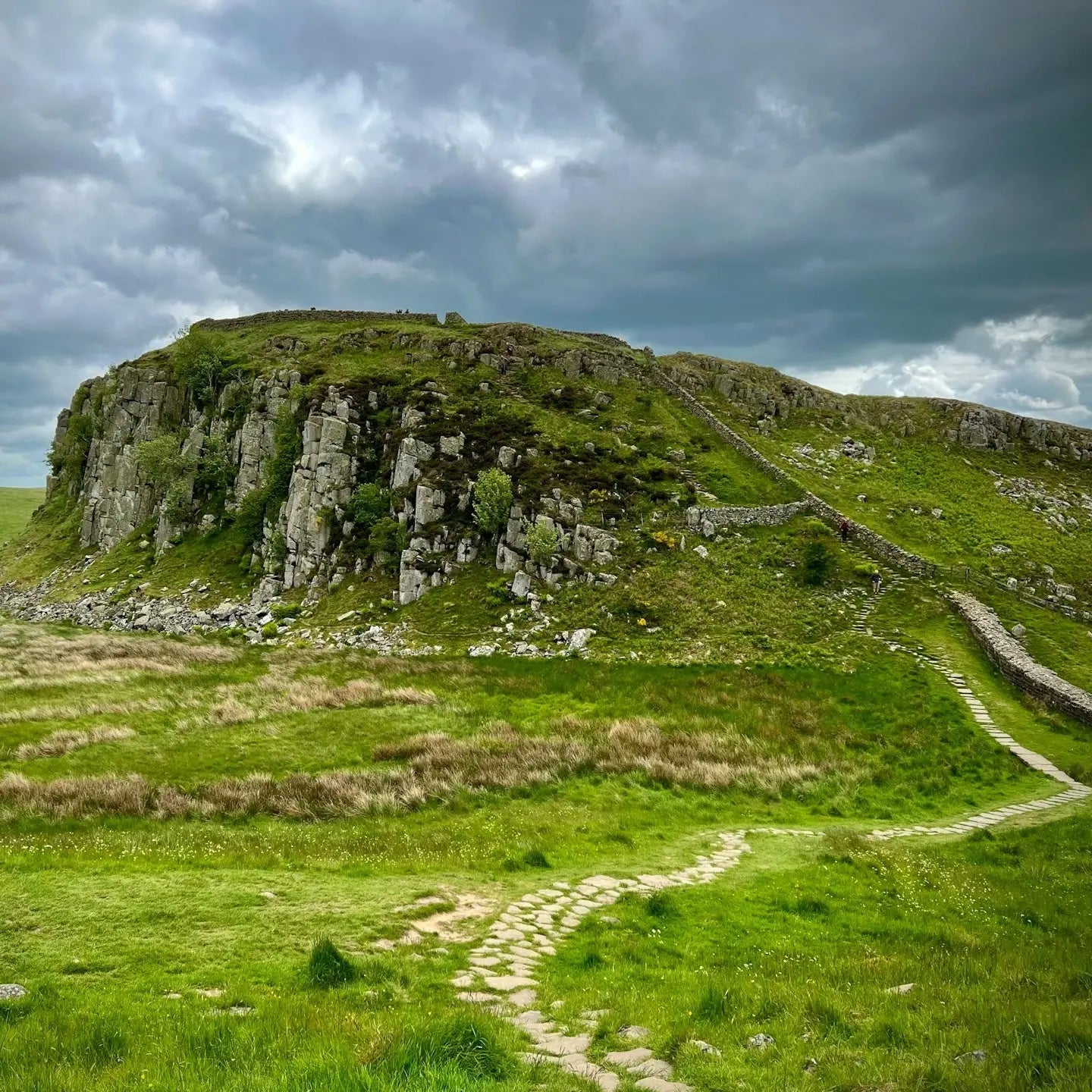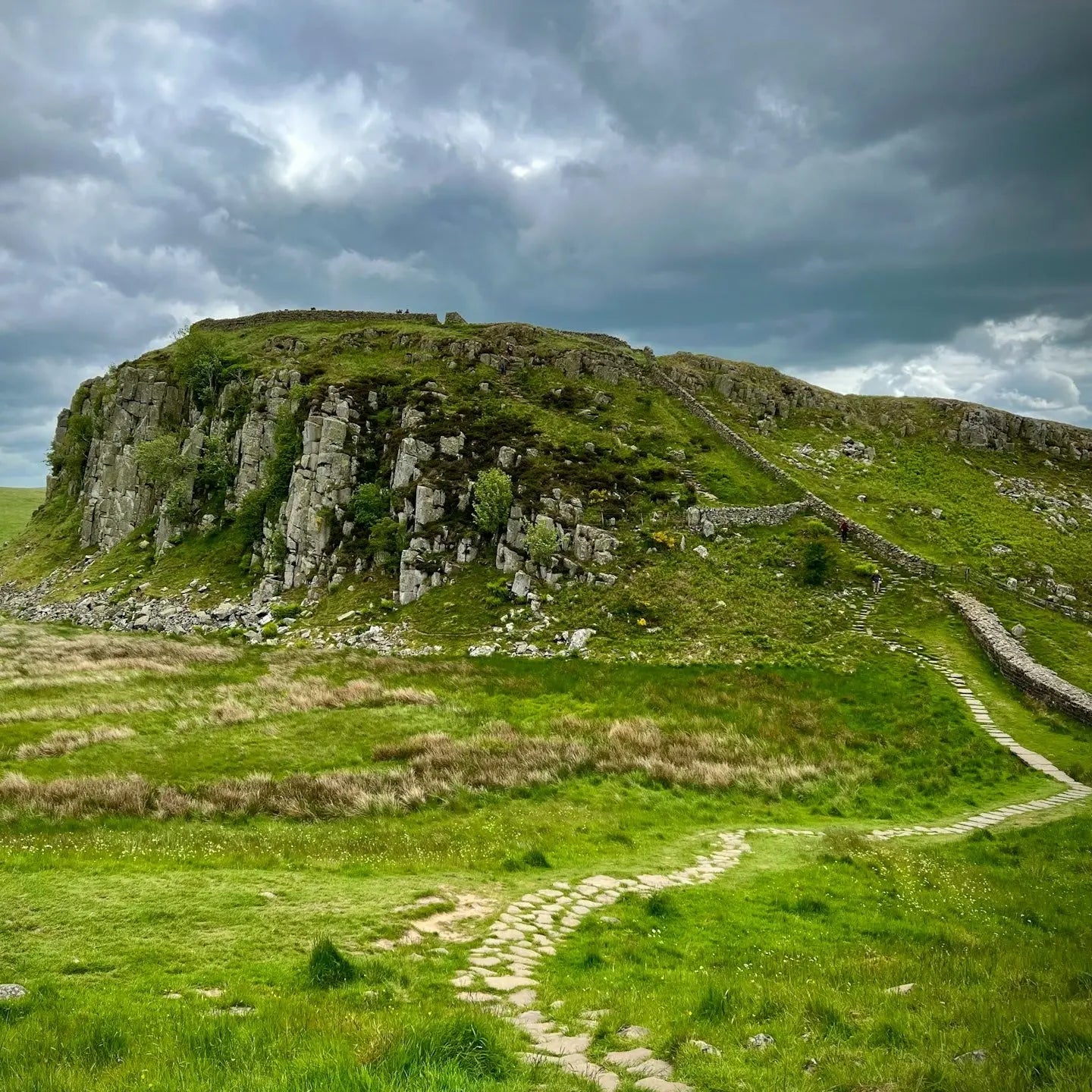Hadrian's Wall Path Overview
- Ancient Roman frontier exploration
- Coast-to-coast British landscapes
- Accessible historical immersion
Hadrian's Wall Path traverses 135 kilometers across northern England, following the impressive remains of the Roman Empire's northernmost frontier. This UNESCO World Heritage trail stretches coast-to-coast from Wallsend in Newcastle upon Tyne to Bowness-on-Solway, cutting through the stunning landscapes of Northumberland and Cumbria. With modest elevation changes rarely exceeding 350 meters, the path offers accessible hiking while providing intimate access to remarkably preserved 1,900-year-o... Read more
| Hilliness | |
| Start Point | Wallsend, Newcastle upon Tyne |
| End Point | Bowness-on-Solway |
| Activity Type | Walking, Hiking, Trail Running |
| Distance | 135km | 84 miles |
| Ascent | 2,100m | 6,889ft |
| When to go | May through September |
| Baggage Transfer | Available |
From £416.00
Based on a Standard Package for two people.
Build Your Adventure
Not ready to book?
Call us on 0131 560 2740
or enquire by email
What's included?
-
Custom Adventure Plan
-
Accommodation options for you
-
Door‑to‑door GPX in our app
-
On‑trail support
-
Share with up to four people
Sample Itinerary
Here's what's on the trail. We'll split the stages to each day just right for your pace.
Key Features: Segedunum Roman Fort, River Tyne, Tyne Bridges, Wylam
Cultural Notes: Urban to rural transition, industrial heritage sites
Your journey begins at Segedunum Roman Fort in Wallsend, where an excellent museum provides crucial context for the trek ahead. This first stage predominantly follows the River Tyne westward through Newcastle's evolving cityscape, passing beneath the iconic seven bridges that span the river. While actual wall remains are sparse in this urban section, interpretive panels highlight where the frontier once stood.
After Newcastle, the trail transitions through increasingly rural landscapes, particularly after Newburn, where woodland paths and riverside trails offer peaceful walking. Water is readily available throughout this section from cafés and pubs. The terrain is generally flat until approaching Heddon-on-the-Wall, where a gentle climb rewards with the first substantial wall section – a 10-meter length standing several courses high.
Heddon-on-the-Wall provides essential services including accommodation, a village pub serving meals, and a small shop for basic supplies. This first day establishes the historical narrative that will deepen throughout your journey, transitioning from industrial heritage to the ancient Roman frontier.
Key Features: Vallum earthworks, Planetrees Wall section, Brunton Turret, Chesters Roman Fort
Cultural Notes: Rural Northumberland, agricultural landscape shaped by Roman occupation
Departing Heddon, the trail enters quintessential Northumbrian countryside with expansive views across rolling farmland. The route initially follows the Military Road (B6318), built directly atop the wall's foundation in the 1750s. Wall remnants become increasingly frequent as you progress westward, with notable stops at Planetrees and Black Carts sections showing the transition from broad to narrow wall construction – evidence of Roman budget constraints during the massive building project.
The middle section traverses gentle hills with several short, moderate climbs. Distant views of the North Pennines emerge on clear days. At Brunton Turret, you'll encounter a well-preserved watchtower demonstrating the regular defensive spacing along the wall. Water sources become more limited in this section – carry sufficient supplies between settlements.
The day concludes at Chollerford, home to Chesters Roman Fort and Museum. This excellently preserved cavalry fort features some of Britain's best-preserved Roman bathhouse remains. The nearby George Hotel offers accommodation and dining, while the site museum provides valuable insights into frontier life. This stage deepens your understanding of the wall's military function while enjoying classic English countryside views.
Key Features: Brocolitia Fort, Housesteads Roman Fort, Sycamore Gap, Steel Rigg
Cultural Notes: Most dramatic wall sections, central defensive positions, Temple of Mithras
This spectacular stage delivers the most iconic Hadrian's Wall landscapes. Departing Chollerford, the trail climbs gradually toward higher ground, passing Brocolitia Fort with its atmospheric Temple of Mithras – evidence of the diverse religious practices within the Roman military. The terrain becomes increasingly dramatic as you approach the volcanic ridge known as the Whin Sill.
The middle section presents the most challenging walking of the entire route, with several steep but short ascents and descents along the undulating ridgeline. These efforts are abundantly rewarded with breathtaking views across Northumberland National Park. Housesteads Roman Fort, Britain's most complete example of a Roman fort, sits dramatically perched on a commanding hilltop position with exceptionally well-preserved granaries, barracks, and latrines.
Beyond Housesteads, the trail reaches its most photographed location – Sycamore Gap, where a solitary tree stands in a dramatic natural dip in the landscape (famously featured in the film "Robin Hood: Prince of Thieves"). The section between Housesteads and Steel Rigg offers continuous wall remains winding spectacularly along the ridgeline. Water is available at visitor centers at Housesteads and Once Brewed. The Once Brewed area offers accommodation at the Twice Brewed Inn and the Youth Hostel, both providing meals and packed lunch services for the following day.
Key Features: Aesica (Great Chesters) Fort, Walltown Crags, Thirlwall Castle, Birdoswald Roman Fort
Cultural Notes: Transition from Northumberland to Cumbria, frontier landscape changes
From Once Brewed, the path continues along the spectacular Whin Sill ridge, offering more dramatic scenery similar to the previous day's highlights. Walltown Crags provides some of the path's most dramatic vistas, with the wall dramatically perched atop volcanic cliffs. This section contains excellently preserved milecastles – the small fortlets positioned every Roman mile along the wall's length.
After Walltown Quarry, the landscape gradually transitions from rugged upland to gentler terrain as you leave the Whin Sill behind. Gilsland straddles the Northumberland-Cumbria border, marking a transition point in the wall's construction. The small Roman fort of Aesica (Great Chesters) offers fascinating archaeology with minimal crowds compared to larger sites.
The approach to Gilsland passes medieval Thirlwall Castle, built using stones pilfered from the wall – a perfect example of how the wall has been repurposed throughout history. Birdoswald Roman Fort near Gilsland houses excellent exhibitions and retains unusually well-preserved granary buildings. Gilsland itself offers accommodation options including Brookside Villa and Gillsland Spa Hotel. Water and supplies are available in Gilsland village. This day combines impressive natural scenery with deepening insights into frontier life through varied archaeological remains.
Key Features: Pike Hill Signal Tower, Harrow's Scar Milecastle, Banks Turret, River Irthing
Cultural Notes: Changing wall construction methods, rural Cumbrian farming landscapes
From Gilsland, the trail follows the wall's course through increasingly pastoral Cumbrian countryside. The wall's construction noticeably changes in this region – while eastern sections primarily used stone, here you'll notice evidence of turf and timber construction, reflecting adaptation to available local materials. The well-preserved Pike Hill Signal Tower demonstrates the sophisticated communication network that operated along the frontier.
The path crosses the scenic River Irthing at Willowford, where impressive bridge abutments show how the Romans engineered the wall across waterways. A moderate climb leads to Harrow's Scar Milecastle, offering excellent views back across the river valley. The terrain throughout this section is generally gentle with occasional short climbs.
As you progress westward, the landscape becomes increasingly dominated by pastoral farming. While wall remains become less prominent, the vallum – the massive earthwork system that ran behind the wall – remains clearly visible, creating a distinctive ripple in the landscape. Water sources are limited between settlements in this section. Walton village offers basic accommodation at Sandysike Farm and the Centurion Inn public house, which serves evening meals. This quieter stage provides insight into the wall's varied construction and its relationship with the surrounding agricultural landscape.
Key Features: Castlesteads Fort site, River Eden, Carlisle Castle, Tullie House Museum
Cultural Notes: Agricultural hinterland, medieval Carlisle, border city history
From Walton, the trail continues through tranquil farmland where the wall itself has largely vanished, though its course remains clearly defined. The site of Castlesteads Fort, though mostly lost to erosion, offers interpretive information about this important garrison position. Throughout this section, hedgerows and field boundaries often follow the original line of the wall, demonstrating how this ancient structure continues to shape the modern landscape.
The terrain remains gentle with minimal elevation changes, making for comfortable walking. The trail gradually approaches the River Eden, offering pleasant riverbank sections before entering the outskirts of Carlisle. This historic border city has been contested between England and Scotland for centuries, adding another historical dimension to your journey.
Carlisle Castle, though medieval rather than Roman, helps illustrate how this frontier zone remained strategically important long after Rome's departure. Tullie House Museum contains an excellent Hadrian's Wall exhibition that contextualizes what you've experienced on the trail. Carlisle offers numerous accommodation options across all price ranges, restaurants, and full resupply facilities. The city's railway station provides connections to major cities if needed. This stage contrasts rural tranquility with urban history, demonstrating how the frontier evolved from Roman times through the medieval period to the present.
Key Features: River Eden, Burgh Marsh, Drumburgh Castle, Solway Firth, Trail End Pavilion
Cultural Notes: Coastal landscapes, salt marshes, Scotland views, smuggling history
The final stage follows the meandering course of the River Eden before approaching the vast Solway Firth estuary – the natural western terminus of the wall. The landscape becomes increasingly coastal, with distinctive salt marshes and expansive views across the Solway to Scotland. While little of the physical wall remains, you're walking through an important frontier landscape where Roman control met the sea.
The terrain is predominantly flat, making for a gentle conclusion to your journey. Drumburgh, approximately halfway through this stage, contains the remains of Drumburgh Castle, built with stones repurposed from the wall. Beyond Drumburgh, the trail closely follows the Solway coast, offering abundant birdlife, particularly in spring and autumn migration periods.
Port Carlisle reveals remnants of an ambitious but short-lived 19th-century shipping channel that attempted to make Carlisle a major port – a reminder that this landscape has witnessed numerous ambitious infrastructure projects beyond just Hadrian's Wall. Water and refreshments are available at pubs in Burgh-by-Sands and Drumburgh.
The trail concludes in the charming village of Bowness-on-Solway, built directly over the site of the Roman fort of Maia. The Trail End Pavilion provides certificates for those who have completed the path. Accommodations include Kings Arms and Shore Gate House B&B. This final day emphasizes the natural frontier quality of the Solway estuary while bringing your journey full circle from the eastern sea at Wallsend to the western sea at Bowness.
How long will it take?
Everyone has a different approach to trails. Here are our suggested times for the Hadrian's Wall Path for different types of adventurers.
Here we have assumed that you will be out on the trail for around 8 hours per day, including regular breaks but not extended lunch stops.

6
Days
For walkers who love the journey as much as the destination.
You enjoy full days on the trail, moving steadily, soaking up the scenery — with plenty of time for food and drink stops along the way!

5
Days
For long-distance walkers who enjoy the challenge of a steady pace over varied terrain.
You’ve got the fitness to cover strong distances over several days — this is where most keen hikers will find themselves.

4
Days
The first of our faster categories — built for those who prioritise pace.
You move quickly with minimal stops, carry just the essentials, and have the fitness to handle long days and tough terrain.

3
Days
Our fastest pace – ideal for those used to ultramarathons.
You mix fast hiking with running on flats and descents, even over mountains. Speed and efficiency matter most, with minimal stops as you aim to complete each route as quickly as possible.
Build Your Adventure
Book by phone
Essential Travel Information
The optimal hiking season for Hadrian's Wall Path runs from May through September, when daylight hours are longest and trail conditions are generally dry. Early May offers spectacular wildflower displays and fewer fellow hikers, while July and August provide the warmest temperatures but coincide with British school holidays, bringing increased trail traffic.
Weather in northern England remains changeable year-round. Even summer hikers should prepare for rain and wind, particularly in exposed sections along the central ridgeline. Spring and autumn bring increased precipitation, though often interspersed with perfect clear days. Winter hiking, while possible for experienced trekkers, faces challenges including short daylight hours (as little as 7-8 hours), muddy trail conditions, and limited accommodation availability as many providers close seasonally.
Specific seasonal hazards include:
- Spring: Occasional snowmelt creating boggy sections in lower areas
- Summer: Rare but possible heat exposure in exposed central sections
- Autumn: Slippery leaf-fall on wooded sections, increasing mud
- Winter: Icy conditions on higher ground, especially the central ridge
Most accommodation and service providers operate from Easter through October, with reduced availability in shoulder seasons. Archaeological sites and museums typically maintain similar schedules, with reduced hours outside peak season.
Hadrian's Wall Path offers diverse accommodation options suitable for different preferences and budgets:
B&Bs and Guesthouses: The most abundant option, typically ranging from £60-100 per night for single occupancy, £80-120 for double/twin rooms. Premium properties with ensuite facilities in popular locations like Once Brewed or Twice Brewed may command higher rates during peak season. Advance booking recommended 3-6 months prior for summer hiking, 1-2 months for shoulder seasons.
Hotels: Available in larger settlements including Newcastle, Carlisle, Chollerford (George Hotel), and Once Brewed (Twice Brewed Inn). Prices range from £80-150 per night. These often provide additional services like packed lunches and evening meals.
Hostels: Youth Hostels are available at key locations including Newcastle, Carlisle, and Once Brewed. Dorm beds range from £20-30, while private rooms (where available) cost £50-70. These provide excellent value and opportunities to meet fellow hikers.
Camping: Designated campgrounds exist at strategic intervals including Twice Brewed, Winshields Farm, and Gilsland. Prices typically range from £8-15 per tent. Some farms offer basic camping by arrangement. Wild camping is not legally permitted along the route as most land is privately owned.
Popular stopover points include:
- Heddon-on-the-Wall (Day 1)
- Chollerford/Chesters (Day 2)
- Once Brewed/Twice Brewed (Day 3)
- Gilsland (Day 4)
- Walton or Brampton (Day 5)
- Carlisle (Day 6)
- Bowness-on-Solway (Finish)
Many accommodation providers offer luggage transfer services through companies like Hadrian's Wall Baggage Transfer or Sherpa Van, ranging from £8-12 per bag per stage.
Air Access:
- Newcastle International Airport (NCL): Most convenient for eastern terminus, with direct connections to major European hubs. 20-minute Metro connection to Newcastle city center.
- Manchester Airport (MAN): Larger international gateway with wider connections, approximately 3 hours by train to Newcastle or Carlisle.
- Edinburgh Airport (EDI): Alternative option, approximately 2.5 hours by train to Newcastle or Carlisle.
Rail Connections:
- Newcastle Central Station: Major hub on East Coast Mainline with direct services to London (3 hours), Edinburgh (1.5 hours), and Manchester (2.5 hours).
- Carlisle Station: On West Coast Mainline with connections to London (4 hours), Glasgow (1.5 hours), and Manchester (2 hours).
- MetroCentre Station provides the closest rail access to Heddon-on-the-Wall by short taxi ride.
Local Transportation:
- AD122 Hadrian's Wall Bus: Seasonal service (April-October) connecting key sites between Hexham and Haltwhistle, including Chesters, Housesteads, and Once Brewed. Runs approximately hourly during peak season.
- The 185 bus connects Carlisle to Bowness-on-Solway with limited service (typically 3-4 departures daily).
- Tyne Valley Line connects Newcastle with Hexham and Carlisle, serving stations near the trail.
Trailhead Access:
- Eastern Terminus (Wallsend): Accessible via Newcastle Metro to Wallsend station, then 10-minute walk to Segedunum Roman Fort.
- Western Terminus (Bowness-on-Solway): Limited bus service from Carlisle (185 service).
Evacuation Points:
- Heddon-on-the-Wall: Taxi to MetroCentre station
- Chollerford: Bus connections to Hexham for rail services
- Once Brewed: AD122 bus to Hexham or Haltwhistle
- Gilsland: Limited bus service or taxi to Haltwhistle station
- Walton: Taxi service to Brampton for rail connections
- Carlisle: Full transportation hub with rail and bus connections
Accommodation Costs (per person):
- Budget: £25-45/night (hostels, basic B&Bs, camping)
- Mid-range: £50-80/night (standard B&Bs, guesthouses)
- Premium: £90-150/night (luxury B&Bs, hotels)
Transportation Expenses:
- Return rail travel London-Newcastle/Carlisle: £100-180 (advance purchase)
- Return rail travel Edinburgh/Manchester-Newcastle/Carlisle: £50-90
- Airport transfers: £10-30
- AD122 Hadrian's Wall Bus day ticket: £12
- Carlisle-Bowness bus (one-way): £5
- Luggage transfer services: £60-80 total for complete path (one bag)
Food and Supplies:
- Breakfast: Usually included in accommodation
- Packed lunch: £5-8 from accommodation providers or local shops
- Evening meals: £15-25 in pubs/restaurants
- Trail snacks and additional supplies: £5-10/day
- Water: Tap water widely available (carry refillable bottle)
Additional Fees:
- Museum and archaeological site entries: £20-40 total (various combination tickets available)
- National Trust/English Heritage membership can offset entrance fees if you plan to visit multiple sites
- Guided tours at major sites (optional): £5-10 per site
Typical Total Budget (excluding travel to/from UK):
- Budget: £500-700 for complete path (7 days, 6 nights)
- Mid-range: £700-1,000
- Premium: £1,000-1,500
Hadrian's Wall Path has seen steadily increasing popularity since its designation as a National Trail in 2003, now attracting approximately 11,000 end-to-end hikers annually alongside thousands more day walkers.
Peak Season Patterns:
- Highest traffic: Late July through August (British school holidays)
- Secondary peak: Bank holiday weekends (early/late May, late August)
- Central sections between Housesteads and Steel Rigg experience the greatest visitor density, with hundreds of day visitors during summer weekends
Quieter Alternatives:
- Mid-week hiking even during summer months significantly reduces encounters
- Early May and late September offer excellent walking conditions with dramatically reduced trail traffic
- Western sections (beyond Walton toward Carlisle) remain relatively quiet year-round
- Eastern urban sections see consistent local use but minimal tourist traffic
Cultural Considerations:
- Trail crosses private farmland – adhere to countryside code by closing gates, controlling dogs, and respecting livestock
- Archaeological remains are legally protected – walking on wall remains is prohibited
- Local communities have complex relationships with tourism – smaller villages appreciate respectful visitor behavior
Typical Hiker Demographics:
- Predominantly 40+ age group for through-hikers
- Significant international representation, particularly from Germany, Netherlands, North America, and Australia
- Day hikers represent broader demographics, including families and school groups at central sections
- Approximately 60% of through-hikers walk west-to-east (contrary to guidebook recommendation) to have prevailing winds at their back
Opportunities for Solitude:
- Early morning starts (before 8am) provide solitary experiences even in peak season
- Western sections (Carlisle to Walton) offer genuine solitude throughout the season
- Urban sections through Newcastle suburbs see minimal tourist traffic
- Winter hiking provides near-complete solitude but requires experience with challenging conditions
Hadrian's Wall Path strikes an excellent balance between accessibility and wilderness. While central sections can become busy during peak periods, thoughtful timing and pace planning can deliver a deeply personal experience of this ancient frontier landscape.

